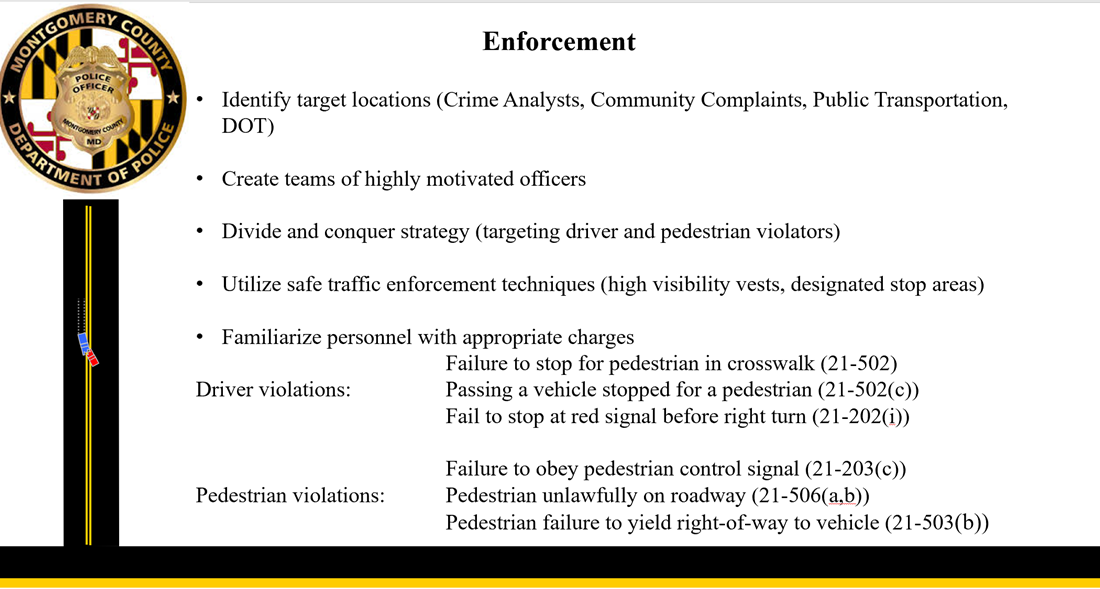If you speak with anyone who works on pedestrian safety, they often talk about the three Es: Engineering, Education, Enforcement. At the TPB Bicycle and Pedestrian Subcommittee’s annual Pedestrian Enforcement Workshop on September 27, planners and law enforcement officers from across the region gathered to discuss that third E, enforcement.
Planners spoke about the pedestrian safety problem, across the region and in their own jurisdictions, while law enforcement officers explained their enforcement programs, and the way traffic engineering, education, and law enforcement work together to target unsafe locations and unsafe behaviors. The workshop concluded with a live pedestrian enforcement action by District of Columbia police on North Capitol Street.
Traffic enforcement sometimes takes a back seat to other priorities. Officers need training to be able to enforce traffic law with confidence, support from their agencies and the public, and the knowledge that traffic enforcement saves lives. The enforcement workshop allows experienced planners and police officers, from jurisdictions with active pedestrian safety and enforcement programs, to share their experiences and lessons learned with their peers.
Enforcement Works
Most people are familiar with speeding enforcement, when a driver gets pulled over or through speed cameras. Speed enforcement is important because the faster a vehicle is moving the harder it is to stop and it is more likely to result in fatalities. As George Branyan of the District Department of Transportation put it, “speeding enforcement is safety enforcement.”

In the presentations from DC and Montgomery County, a common theme centered on how data can inform when, where, and how to enforce the traffic laws. Data can pinpoint a specific location that needs some intervention. Or can show when more fatal crashes happen. In Montgomery County there were more crashes during the evening rush but the most fatalities occurred in the early morning hours. These types of data can help focus attention to where and when and how enforcement would be most beneficial.
In Montgomery County, enforcement was a key piece along with education and engineering to fix a specific location in Wheaton. There, a combination of education, enforcement, and eventually engineering are beginning to make the area safer.

In Montgomery County the Wheaton Triangle area was targeted for safety interventions including engineering, education, and enforcement. This slide illustrates the enforcement plan. (Montgomery County)
In the Wheaton Triangle area in addition to law enforcement, Street Smart Street Teams went out to speak with pedestrians and other road users to educate people. They also were able to learn from people on the street about what could be changed to make it easier and safer to get around. These interactions were then relayed back to planners and engineers to look at how to make the area safer for everyone. While, engineering often takes the longest to build and fix areas to make them safer, enforcement and education can be deployed quickly.
How targeted enforcement works
When law enforcement head out to an area to conduct these targeted enforcement operations they have one officer cross the street while another officer in a marked police car waits down the street. The officer may use a cone to mark a reasonable distance that a vehicle might be before stepping out into the crosswalk to ensure the driver has a reasonable stopping distance. If the driver doesn’t stop, the officer radios to the officer down the street to ticket the driver.
Police often work with agency public relations staff and the media to publicize their enforcement efforts. Here is one example from a news report about a targeted operation conducted recently in Arlington and reported by NBC News 4.
Watch the news report.
The workshop clearly demonstrated that enforcement and education work well together. In November we will be kicking off the fall Street Smart campaign. As always, but especially as the days get shorter, we all have to stay alert and look out for one another to stay safe on the streets.
Learn more about the TPB Bicycle and Pedestrian subcommittee.
Learn more about Street Smart.